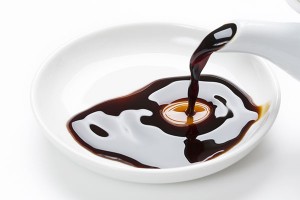In Japan, shoyu is the most quintessential of all seasonings. Its irresistible charm lies in its rich flavor, well-rounded aroma, and beautiful color. Shoyu has a superb balance of the five basic tastes – sweet, salty, sour, bitter, and umami – and gives off a wonderfully appetizing fragrance when heated. This is a truly magical seasoning, able to bring out the best of every ingredient. It is this quality that prompts the Japanese cook to reach for the shoyu whenever a dish is lacking in flavor.Show more...
What are the origins of soy sauce?
The origins of soy sauce can be traced back to China, where references to a soy sauce-like condiment were first recorded around 800 BCE. By the beginning of the seventh century, a similar condiment appeared in Japanese records. However, shoyu is very much a Japanese food. After its introduction from China, soy sauce underwent a long period of development, eventually becoming the shoyu we know today, a condiment used to enhance the flavor of other ingredients.
The key period in this development was the Edo period (1603-1868). During this time, Edo (now Tokyo) grew dramatically, bringing with it great social change and new economic demands. This also prompted innovation: new varieties of shoyu were developed to meet the tastes of Edoites. Shoyu became an indispensable accompaniment to many of the dishes perfected during this period and which today are considered quintessentially Japanese, including tempura and sushi.
When did soy sauce become known overseas?
The Edo period also saw the first exports of shoyu to the rest of the world. Shoyu was shipped overseas on Dutch boats sailing from the Dejima trading post, bound for countries across Asia and Europe. One destination was the court of Louis XIV, who ruled France from 1643 to 1715. The Sun King and his courtiers were delighted with this exotic new ingredient, made in a far-off land and sweet, salty, and savory all at once.
Exports of shoyu have continued to grow, especially as the reputation of Japanese cuisine as healthy and balanced has grown. Shoyu in particular has established itself as a versatile product with applications beyond Japanese cooking. Today, it is popular across the world with cooks working in a wide variety of different cuisines.
In Japan, soy sauce is divided into a number of categories, but most of the soy sauce available outside of Japan is either shoyu or tamari. The main difference between the two types is the ingredients used. Shoyu is made from soybeans, wheat, water, and salt, while tamari contains little to no wheat. Mitoku’s tamari is free from wheat and gluten. Our soy sauces are the finest quality available, manufactured by our artisan producers using traditional recipes passed down for generations and top quality non-GMO soybeans.




